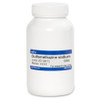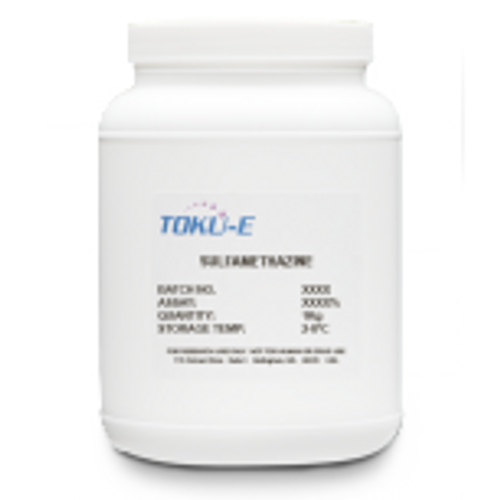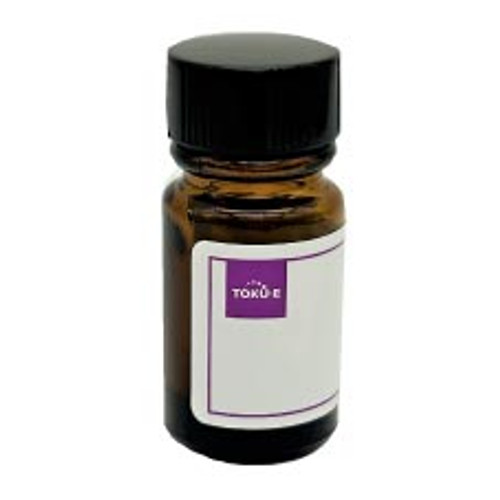Sulfamethazine Sodium (syn: Sulfadimidine Sodium) is a bacteriostatic heterocyclic sulfonamide antibiotic that was first synthesized from sulfanilamide at Temple University in Philadelphia by William Caldwell in 1942. Sulfamethazine has broad-spectrum antimicrobial activity effectively targeting bacteria causing bronchitis, prostatitis, and urinary tract infections. It is used in disposition and depletion studies of kinetics and to develop procedures used for quantification. Sulfamethazine is also an inducer of CYP3A4.
Sulfamathazine has been shown to suppress epigenetic silencing in Arabidopsis by impairing folate synthesis.
Sulfamethazine blocks the synthesis of dihydrofolic acid by inhibiting the enzyme dihydropteroate synthase. Sulfamethazine is a competitive inhibitor of bacterial para-aminobenzoic acid (PABA), which is required for bacterial synthesis of folic acid. It induces CYP3A4 expression and is acetylated by N-acetyltransferase.
Sulfamethazine is soluble in DMSO (56 mg/mL at 25° C). It is very slightly soluble in water and ethanol.
| Mechanism of Action | Sulfonamides, like Sulfamethazine Sodium, inhibit the enzymatic conversion of pteridine and p-aminobenzoic acid (PABA) to dihydropteroic acid by competing with PABA for binding to dihydrofolate synthetase, an intermediate of tetrahydrofolic acid (THF) synthesis. THF is required for the synthesis of purines and dTMP and inhibition of its synthesis inhibits bacterial growth. |
| Spectrum | Sulfamethazine Sodium, like other sulfonamides, is a broad-spectrum antimicrobial inhibiting both Gram-positive and Gram-negative bacteria, as well as some protozoa, such as coccidia. They are considered ineffective against most obligate anaerobes. However, they may affect aerobic organisms that contribute to the lowered oxygen tension in the microenvironment and, as such, they may be useful in certain diseases involving Fusobacteria, although the organism itself is often resistant. |
| Microbiology Applications | Sulfamethazine Sodium is commonly used in clinical in vitro microbiological antimicrobial susceptibility tests (panels, discs, and MIC strips) against Gram-positive and Gram-negative microbial isolates. Medical microbiologists use AST results to recommend antibiotic treatment options. |
| Plant Biology Applications | Sulfamethazine (SMZ) is a chemical suppressor of epigenetic silencing. SMZ treatment released the silencing of transgenes as well as endogenous transposons and other repetitive elements. Plants treated with SMZ exhibit substantially reduced levels of DNA methylation and histone H3 Lys-9 dimethylation, but heterochromatic siRNA levels were not affected. SMZ is a structural analog and competitive antagonist to p-aminobenzoic acid (PABA), which is a precursor of folates. SMZ decreased the plant folate pool size and caused methyl deficiency, as demonstrated by reductions in S-adenosylmethionine levels and in global DNA methylation. Exogenous application of PABA or compounds downstream in the folate biosynthesis pathway restored transcriptional silencing in SMZ-treated plants. |
| Molecular Formula | C12H14N4O2SNa |
| References |
Allegra CJ, Boarman D, Kovacs JA et al (1990)Interaction of sulfonamide and sulfone compounds with Toxoplasma gondii dihydropteroate synthase. J. Clin. Invest. 85(2):371-379 Appelgate J (1983) Clinical pharmacology of sulfonamides. Mod. Vet. Pract 1983: 667-9 Duran SP, Valera RC, Manzano JV, et al. Comparative in-vitro susceptibility of Bacteroides and Fusobacterium isolated from footrot in sheep to 28 antimicrobial agents. J Vet Pharmacol Ther 1991; 14: 185-92 McDougald LR, Galloway RB (1973) Eimeria tenella: Anticoccidial drug activity in cell cultures. Experimental Parasitology. 34(2):189-196 Meyer UA (1994) Interaction of sulfonamide and sulfone compounds with Toxoplasma gondii dihydropteroate synthase. Environ. Health Perspect. 102 (Suppl 6), 213-216 Prescott JF, Baggott, JD, ed. Antimicrobial therapy in veterinary medicine, 2nd ed. Ames, IA: Iowa State University Press, 1993. p. 119-26 Witkamp RF, Nijmeijer SM, Yun H et al (1993) Sulfamethazine as a model compound to assess sex hormone-dependent cytochrome P-450 activity in rats. Drug Metab. Dispos. 32(3):441-446 |








